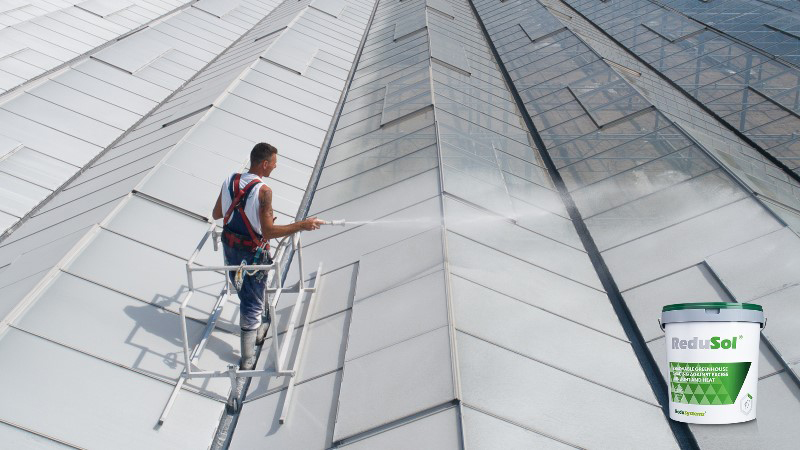Key Insects to Monitor in Greenhouse Hemp
Anytime you grow a large amount of plants, you are going to have pest issues. Hemp is no exception, but how you grow hemp may make a difference in which pests you deal with.
There are a few crossover pests, but indoor crops seem to have fewer issues, and these can be managed with softer spray products and biological control agents. This article focuses on indoor hemp pests. For information on outdoor hemp pests, I highly recommend visiting the Colorado State Hemp Insect website.
Twospotted Spider Mites
Twospotted spider mites (TSSSM, Tetranychus urticae) are a very common pest in many crops. If there is any good news, it is that TSSM has been well-studied, so we understand a lot about its biology and management. This is a pest you must be preventative with; you do not want to wait until you find out that you have an issue.
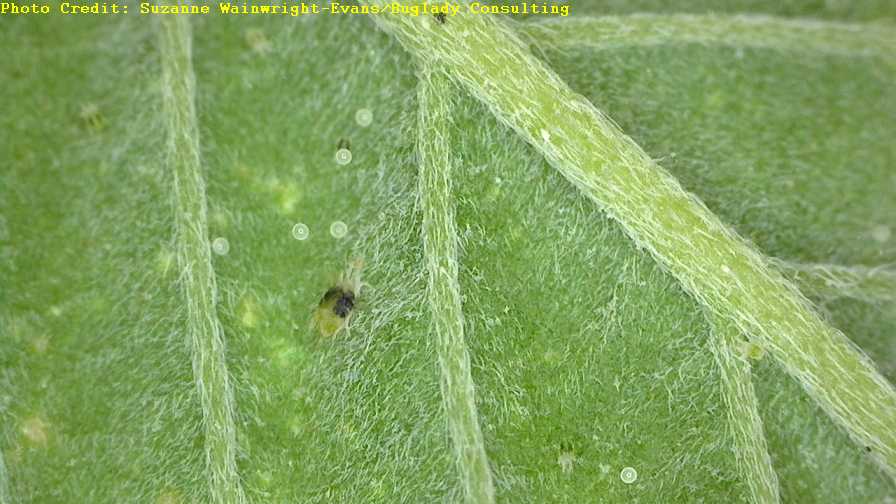
Twospotted spider mite. Photos by Suzanne Wainwright-Evans/Buglady Consulting
Controlling a well-established TSSM population can be very difficult. Therefore, many growers will start their preventive programs right from the start in propagation. At this stage, the plants are close together, and pests are normally in very low numbers. Many hemp growers are opting to use predatory mites at this stage, such as Phytoseiulus persimilis or Neoseiulus californicus. They are very economical to use and will search all over the young plants to find every last TSSM. They can be used under a mist system or even under plastic domes. Many growers will continue with the predatory mites through the vegetative period and into the first week of flower. Once the plant becomes too sticky due to the developing trichomes, the predatory mites will get stuck and cannot be used.
Oils have proven to be very effective in controlling TSSM. Some oils can control all life stages (check with specific manufacturer about which stages their oils control), which can help you get ahead of them. Another advantage to oils is that they work by suffocating the pests, so you do not have to worry about developing resistance to the products. Some growers do rotate with insecticidal soaps, but it is not necessary (from a resistance standpoint). If you choose to spray anything for mites, be sure to check the regulations to make sure the products are allowed for use.
Hemp Russet Mite
Hemp russet mite (Aculops cannabicola) has been a major pest in hemp for several years now and can be very challenging. Due to its small size (about the length of the leg of a spider mite, but shaped like a carrot), it is often overlooked until the populations have exploded. This mite can only live on Cannabis sp. plants, so most growers get it by bringing it in on plant cuttings, and most facilities do not have a quarantine area to stop it from spreading.
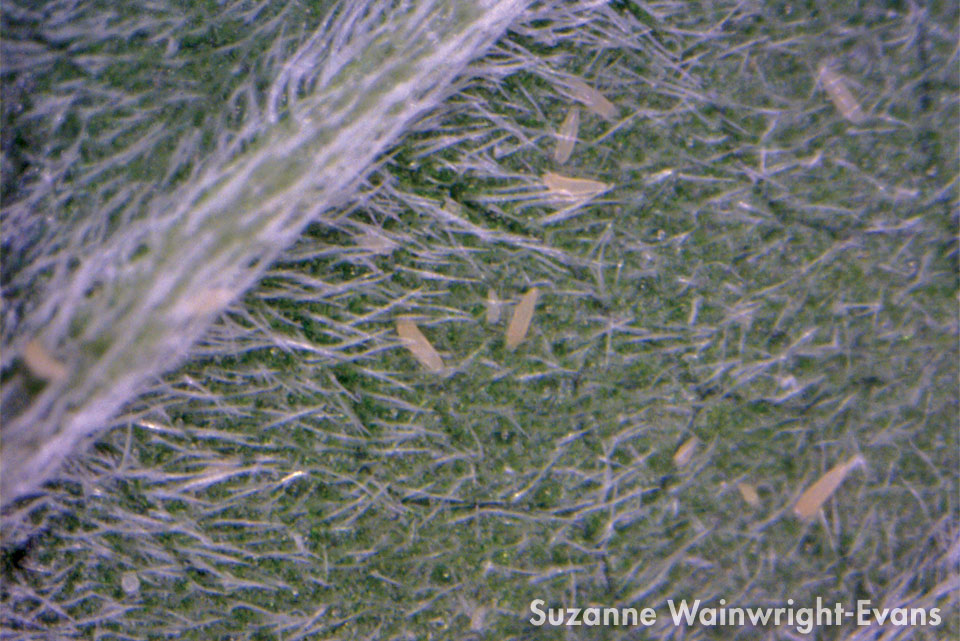
Hemp russet mites.
Growers have found using horticultural oils to be a very effective way to manage this pest. The applicator will have to get excellent spray coverage, coating both sides of the leaves as well as the stems to suffocate the mites and their eggs. Growers with a history of this pest start treating in propagation to prevent it from getting a foothold in the new crop. The damage it causes in hemp includes discoloration, leaf curl, and overall decline in plant health. These symptoms are often not seen until there is a high population, so monitor your crop closely for this pest.
Broad Mites
Broad mite (Polyphagotarsonemus latus) is another mite with many host plants and worldwide distribution. It is a much smaller mite than the twospotted spider mite, and at least 20x magnification is needed to see them (this can depend on your eyes). The adult females are 0.2 mm long, while the males are slightly smaller and oval in shape. The easiest way to identify them is by their eggs. The eggs are elliptical with white tuffs on them, almost looking like they have white dots on them.
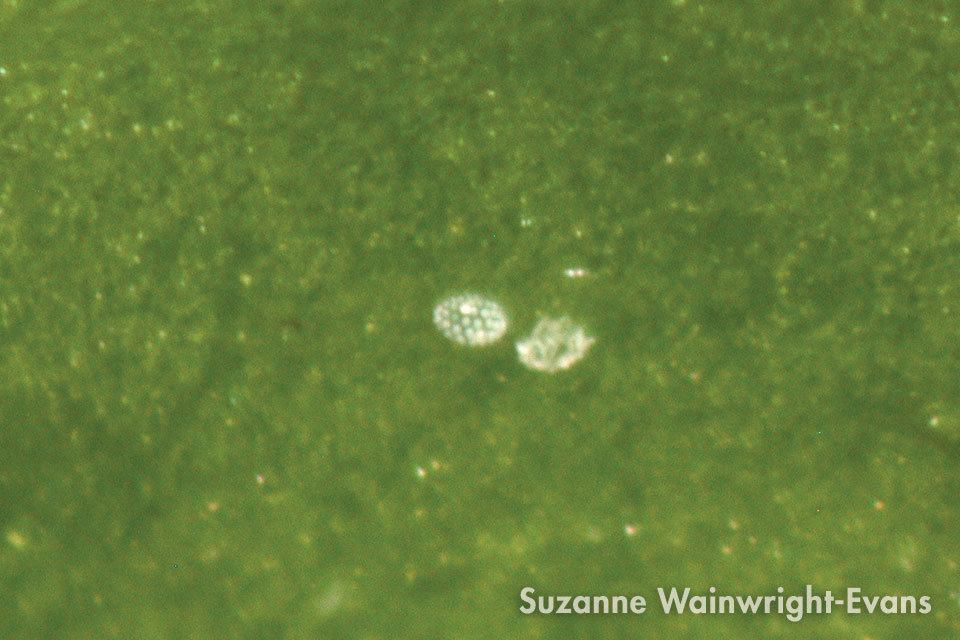
Damage from broad mites.
Their presence can be hard to detect until visible damage has occurred. Unfortunately, this is often the first that growers learn of their presence. Broad mites have a toxic salve that causes new leaves to grow distorted and thickened. Even if treated, these leaves will not recover from this damage. New leaves that come out (that are free of mites) will be normal.
Because broad mite is a pest in many economic crops, we know from experience how to manage them. The predatory mites Neoseiulus cucumeris and Amblyseius swirskii have shown to provide excellent control. They are mostly used as a preventive, but if numbers of the broad mites are low, they can clean them up. These predatory mites are not only feeding on pest mites, but they will also help with other pest issues like some species of thrips. Starting them in propagation is an affordable and effective way to stop several pest issues. Many growers are opting to apply them in slow-release sachets, available from all the major insectaries.
Oils can also be used to help control this pest. They have been proven to work very well.
Aphids
In indoor hemp, there are several aphid species that can be problematic. One good thing is that they are much larger than mites, so they are easier to detect when scouting. Some aphids are common pests to many crops (like melon aphid Aphis gossypii), while others such as the cannabis aphid (Phorodon cannabis) are specific to cannabis plants. Over the last two years, the cannabis aphid has exploded across the country, and can be found in many hemp growing facilities and fields. There has been limited research on this aphid species, and many growers are finding it a challenge to manage it.
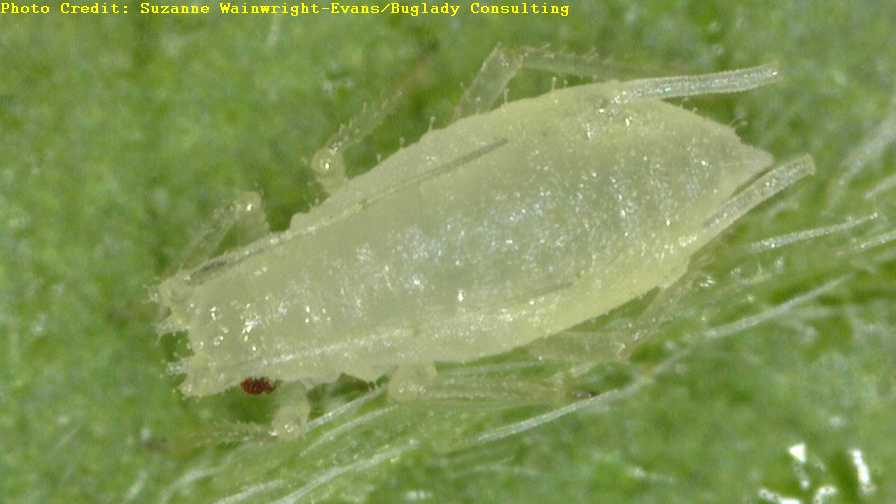
Over the last two years, the cannabis aphid Phorodon cannabis has exploded across the country and can be found in many hemp growing facilities and fields.
As with the other pests, exclusion by not bringing them in on new plant material can prevent a lot of problems. If you do find yourself with a foliar aphid issue, positive identification is the first step. If you need help knowing which one you have, reach out to a qualified individual for help. This is essential if you are going to use biological control. Once you know what kind of aphid you have, only then can you plan an effective management program. To prevent issues, many growers are releasing predators like green lacewing larvae into the propagation flats. An advantage to lacewing larvae is that they are non-selective and will feed on almost any aphid species. There are many other beneficials that can be used to manage foliar aphids. It’s best to confer with your biocontrol specialist to know which one is appropriate for your situation.
Spraying for foliar aphids is another option. Insecticidal soaps have proven to be very effective against aphids, and we are not worried about resistance issues. As with the other pests, it is
essential to get them under control in the early stages of the crop, because once you get later into the crop cycle the beneficials can get stuck in the trichomes. The same is true with spray programs; treat early because you do not want to be spraying once the plants are starting to flower.
Root aphids are another aphid species that has been a real challenge in indoor hemp. Rhopalosiphum rufiabdominalis is the species we are finding frequently, and it is almost impossible to eradicate once it gets into a facility. Macro biocontrol agents have not been successful in controlling it. Where there has been success is in using microbial products that contain actives like Beauveria bassiana and Isaria fumosorosea. These fungal spores must be applied in a way that they come in direct contact with the aphids in the media. This can be very labor intensive and expensive. Sanitation is critical in preventing the spread of this pest.
There are other indoor hemp pests like fungus gnats, thrips, and whitefly, but they have not proven to be a major economic threat to indoor hemp. It is still important to scout for them and treat if found.
The key to being successful is knowing which pests are common in your area, how you grow, or if you have had a history with a pest, and then treat before you have a problem. Prevention and sanitation are key in hemp crops where we have so few spray options to knock down existing problems.
|
Indoor Hemp |
Outdoor Hemp |
|
|






